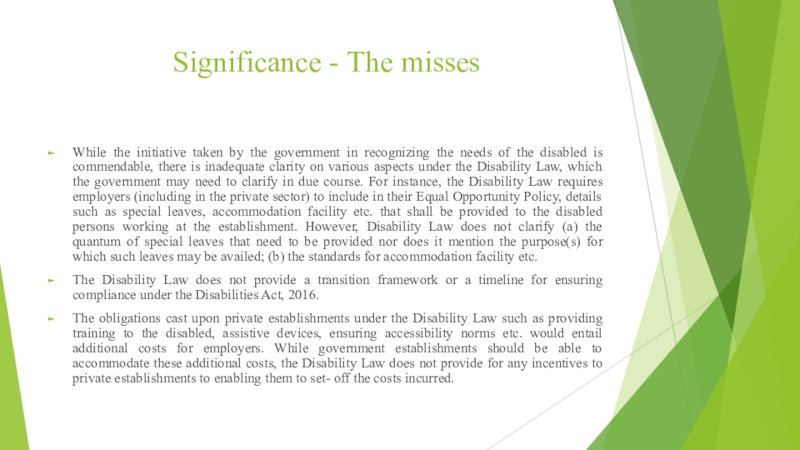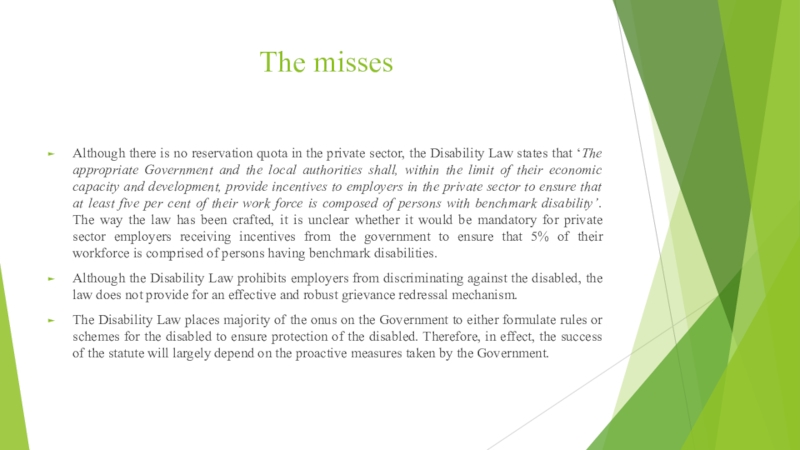Слайд 1The Persons with Disabilities (Equal Opportunities, Protection of Rights and
Full Participation) Act, 1995
Name :- Divyeshkumar Dhamot
Subject :- Medical law
Group no:- 17LL4a
Слайд 2Information
Name: The Persons with Disabilities (Equal Opportunities, Protection of Rights
and Full Participation) Act, 1995.
Country: India
Subject(s): it made it
unlawful to discriminate against people in respect of their disabilities in relation to employment, the provision of goods and services, education and transport.
Type of legislation: Law, Act
Adopted on: 1995
Слайд 3Goals
Appropriate Governments and local authorities to provide children with disabilities
free education, to make schemes and programmes for non-formal education.
Identification
of posts which can be reserved for persons with disabilities.
Special Employment Exchange.
All educational institutions to reserve seats for persons with disabilities.
Non-discrimination in transport, on the road, in the built environment, in Government Employment.
Слайд 4Principles
The core concepts in the DDA 1995 are, instead:
less favorable
treatment for a reason related to a disabled person's disability;
and failure to make a "reasonable adjustment".
employers are likely to find it reasonable to provide accessible IT equipment;
many shops are likely to find it reasonable to make their premises accessible to wheelchair users;
councils are likely to find it reasonable to provide information in alternative formats (such as large print) as well as normal written form.
Слайд 5Structure and main articles
Preliminary
The central coordination committee
The state coordination
committee
Prevention and early detection of disabilities
Education
Employment
Affirmative action
Non-discrimination
Слайд 6Other articles
Research and manpower development
Recognition of institutions for persons
with disabilities
Institution for persons with severe disabilities
The chief commissioner and
commissioners for persons with disabilities
Social security
Miscellaneous
Слайд 7Practical realization
The Rights of Persons with Disabilities Act, 2016 replaces the erstwhile Persons
with Disabilities (Equal Opportunities, Protection of Rights and Full Participation)
Act, 1995.
The law on protection and prohibition of discrimination of the disabled has come into effect on April 19, 2017. The rules thereunder have been made effective from June 15, 2017.
Слайд 8Key features of the disability law
‘Disabled persons’ have been categorized
as: (i) persons with disability; (ii) persons with benchmark disability and
(iii) persons with disability having high support needs.
The definition of ‘person with disability’ under the Disabilities Act, 2016 is an inclusive definition as opposed to the exhaustive definition provided under the Disabilities Act, 1995 and includes 21 types of disabilities as ‘specified disabilities’. The Disabilities Act, 1995 covered only 7 types of disabilities.
While majority of the obligations under the Disability Law are cast upon the appropriate government and/or local authorities; certain obligations/duties are also cast upon establishments (including in the private sector).
All establishments (including in the private sector) are required to frame and publish an Equal Opportunity Policy.
It prohibits discrimination of persons with disabilities, unless it can be shown that the act of discrimination was a proportionate means of achieving a legitimate aim.
Слайд 9Other key features
Additional benefits such as right to free
education (between the age group of 6 and 18 years),
reservation in education, government jobs, allocation of land, poverty alleviation schemes etc. have been provided for persons with benchmark disabilities.
Reservation in vacancies in government establishments7 has been increased from 3% to 4% for certain persons or classes of persons having benchmark disability.
For ensuring speedy trial, special courts are to be constituted in each district to handle cases concerning violation of rights of persons with disabilities.
Enhanced penalties with a monetary penalty extending up to Rs. 500,000 (~USD 7750) and imprisonment extending up to 5 years.
Слайд 10Significance - The hits
With the increase of industries in India,
the role of the corporate sector in generating job opportunities
had increased tremendously. For many years now, there has been a pressing need to create awareness amidst the corporate sector to take active responsibility in recognizing the abilities of disabled persons and give them equal opportunities in the job market. By enacting the Disability Law, the Indian Government has succeeded in promoting equal employment opportunity for the disabled in the private sector as well, by casting mandatory obligations on private employers.
According to the United Nations, around one billion people live with disabilities globally. Among them, 40 to 80 million live in India23. Prejudice, coupled with lack of facilities and opportunities, has often curbed them from leading a normal life. Given the mandatory requirement to build equal opportunities for the disabled, the above statistics are likely to reduce in the years to come.
Слайд 11The hits
The Disability Law aims at addressing the problems faced
by the disabled from all dimensions. It includes not just
the economic and social rights of the disabled, but also includes justiciable rights of the disabled.
Social attitudes and stigma have been a major reason for limiting the opportunities of the disabled whether it be in their social and economic life or even within their own families. Despite the magnitude of the issue, awareness on disability issues have been lacking. To that extent, the government’s initiative to conduct, encourage, support and promote awareness campaigns and sensitization programmes is a remarkable step.
The Disability Law is a sign that the government is making a move towards a more inclusive and progressive society, where persons would not be limited by their disabilities. This would ensure that employment standards in India are brought in line with international standards.
Слайд 12Significance - The misses
While the initiative taken by the government
in recognizing the needs of the disabled is commendable, there
is inadequate clarity on various aspects under the Disability Law, which the government may need to clarify in due course. For instance, the Disability Law requires employers (including in the private sector) to include in their Equal Opportunity Policy, details such as special leaves, accommodation facility etc. that shall be provided to the disabled persons working at the establishment. However, Disability Law does not clarify (a) the quantum of special leaves that need to be provided nor does it mention the purpose(s) for which such leaves may be availed; (b) the standards for accommodation facility etc.
The Disability Law does not provide a transition framework or a timeline for ensuring compliance under the Disabilities Act, 2016.
The obligations cast upon private establishments under the Disability Law such as providing training to the disabled, assistive devices, ensuring accessibility norms etc. would entail additional costs for employers. While government establishments should be able to accommodate these additional costs, the Disability Law does not provide for any incentives to private establishments to enabling them to set- off the costs incurred.

Слайд 13The misses
Although there is no reservation quota in the private
sector, the Disability Law states that ‘The appropriate Government and
the local authorities shall, within the limit of their economic capacity and development, provide incentives to employers in the private sector to ensure that at least five per cent of their work force is composed of persons with benchmark disability’. The way the law has been crafted, it is unclear whether it would be mandatory for private sector employers receiving incentives from the government to ensure that 5% of their workforce is comprised of persons having benchmark disabilities.
Although the Disability Law prohibits employers from discriminating against the disabled, the law does not provide for an effective and robust grievance redressal mechanism.
The Disability Law places majority of the onus on the Government to either formulate rules or schemes for the disabled to ensure protection of the disabled. Therefore, in effect, the success of the statute will largely depend on the proactive measures taken by the Government.
